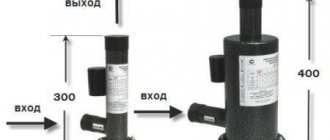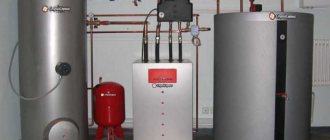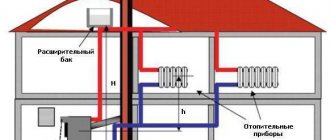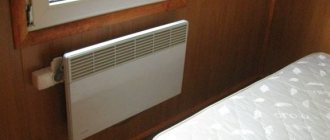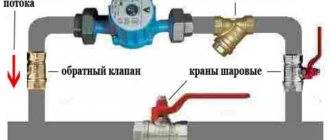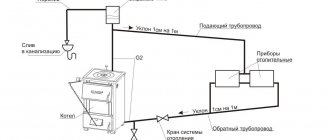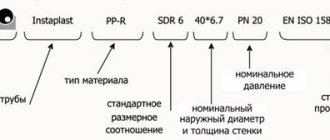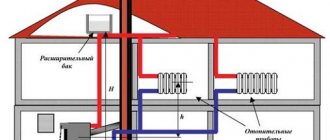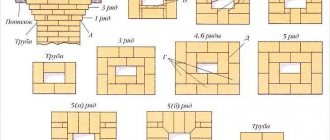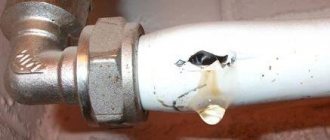Electric boiler installation
Installation of this equipment in a house does not require a chimney and approval from regulatory authorities. The only requirement is that the electrical wiring is in good working order. The connection diagram is quite simple. In addition to the boiler, it includes temperature sensors on the pipelines, a heating radiator, drain and shut-off valves, an expansion tank and a filter with a circulation pump. You will also need a voltage stabilizer, since electric boilers are sensitive to voltage drops, and they are inevitable in the electrical network.
When installing, you must try to isolate it from the water supply system so that if a pipe breaks, water does not enter the unit, causing a short circuit. The installation room must be thermally insulated to prevent the formation of condensation - it can also lead to serious damage. The boiler must be installed on a flat surface.
Connection
To connect equipment, couplings and adapters are used. First, you need to turn off the water supply in the water supply using ball valves. The connection is made in accordance with the installation diagram attached to the accompanying documentation. The circuit assumes the presence of grounding, installation of a circuit breaker, as well as an RCD for short circuit protection.
Cables must be installed in cable ducts, and the electrical part of the equipment is protected by a casing. The unit itself must be securely fastened. And only after that you can let water into the heating system and check the functionality of the equipment.
Safety regulations
Before we move on to the main part of heating installation, I would like to pay attention to the safety of electrical installation work. Firstly, the connection of the electric heating boiler must be carried out when the electricity is turned off
Firstly
, the connection of the electric heating boiler must be carried out when the electricity is turned off.
Secondly
, it must be installed at a certain distance from other objects, namely:
- there must be at least 5 cm of free space between the body and the walls;
- the front panel must be accessible for maintenance; 70 cm of free space is enough;
- the distance to the ceiling is no less than 80 cm;
- the distance to the floor is at least 50 cm (if the electric boiler is of a hanging type);
- the distance to the nearest pipes is at least 50 cm.
Third
, the network must be three-phase (380 V) to reduce the current load on the electrical wiring. When using a single-phase network to connect a powerful boiler, the wiring may not withstand it, resulting in spontaneous combustion and.
DIY video instructions for connecting an electric boiler
— professional installation of electric boilers since 2003. The guarantee for the work we perform is at least two years. Minimum installation time. Coordination of electric heating installation with local services!
| Name of works | Explanation | Cost of work, rub |
| Electric boiler installation | For boilers with power from 0 to 30 kW/h | 12 700 |
| Electric boiler installation | For boilers with power from 31 to 60 kW/h | 15 300 |
| For thermal accumulators up to 500 liters | 12 700 | |
| Installation of a heat accumulator for an electric boiler | For thermal accumulators up to 1000 liters | 15 300 |
Types of electric boilers
For domestic use, we recommend the installation of electric boilers with heating elements that have a very high (99.5%) efficiency. There are also. The power adjustment of an electric boiler with heating elements is usually three-stage. For additional adjustment, a room temperature sensor and a timer for daily or weekly programming of the boiler operating mode (on/off) are used.
Remote control of an electric boiler
To save expensive electricity, you can install a system that allows you to remotely change the temperature in a building heated by electricity. At any time you can raise or lower the temperature using your cell phone. Information about the temperature in the building and the condition of the boiler is available for your control at any time.
Placing an electric boiler in a building
The requirements for the location of an electric boiler are minimal compared to a gas or diesel boiler. The compact size of the boiler, the absence of a chimney and the low noise level during operation allow the boiler to be located in close proximity to residential premises or even in them. The best solution is to place the electric boiler in the technical room. It will be convenient if it is located closer to the electrical panel. To prepare sanitary hot water, you can use an additional storage boiler. For additional compactness of the system, you can use hanging DHW boilers.
You can select the electric boiler model in the catalog.
Operation of an electric boiler with a heat accumulator
In addition to external thermostatic control of the electric boiler, you can use a cheap nightly electricity tariff to save money. To do this, we will need a heat accumulator (a tank with a capacity of 300 liters or more), where we will store the heat generated by our electric boiler during the cheap night tariff. We store heat when it is cheap (at night) and spend it on heating when the electricity tariff is at its highest (during the day). During the daytime, the boiler does not operate or operates at minimum mode, only to reheat the coolant. Our designers will select the required capacity of the heat accumulator!
Installation of electric boilers. Guarantees
We provide our Customers with a two-year warranty on the installation of electric boilers. In some cases, the guarantee may be longer!
Main types of electric heating
Electric boilers and water heating
In those apartments where multi-tariff electricity meters are installed, installing electric heating is doubly justified. At night, electricity tariffs are an order of magnitude lower, so you can use electricity to heat the room more intensively at night.
Modern electric boilers are ideal in operation, simple and convenient devices, almost completely automated. All boiler models are equipped with thermostats, thanks to which the heating intensity of the heating elements is automatically adjusted depending on the temperature in the apartment. The boilers operate silently, which is very important for owners of small apartments and families with small children growing up.
Note: If we compare electric boilers with the operation of gas boilers and units operating on other types of fuel, electric heating of an apartment is much easier to install and can be easily dismantled if necessary. The presence of a machine on the distribution board will ensure that the entire power supply system of the apartment is turned off in the event of malfunctions in the heating system.
Electric boilers operate according to the traditional autonomous heating scheme, heating the coolant in the system. This can be plain water or antifreeze diluted with water in the appropriate proportion. This scheme is most often used at the domestic level, providing good heating of interior spaces. A heating boiler or boiler can be installed in any technical room, in the kitchen or in bathrooms, where there are technical capabilities for installing such equipment.
The consumer market offers wall-mounted electric boilers with a power from 5 to 60 kW, as well as floor-standing models with a power exceeding 60 kW.
The boiler power is selected based on generally accepted technological standards. Heating a room of 10 m2 will require 1 kW of electricity.
Important! Installing a boiler with a power of over 12 kW in a city apartment will require re-equipping the home electrical network and installing a three-phase meter. Installation of a high-power boiler will require obtaining the appropriate permit from the energy company.
The piping layout and methods of connecting radiators are similar to the installation of a water heating system. The only difference is that electric heating boilers are designed to service a small number of batteries, and therefore cannot provide the necessary heat to apartments that are large enough in area.
Direct heating using electricity
As a successful alternative to electric heating using a coolant, heating devices using the principle of direct heating with electricity are considered. Heating of the apartment with electricity is provided without the participation of an intermediate link; there is no coolant in the system. Such systems include portable or stationary convectors, heated floors and other types of electric heating devices. The power of the devices is determined manually or automatically, depending on household needs.
Convectors are the simplest and cheapest method of electric heating. The devices that are offered to consumers today are equipped with the necessary thermostats and have different configurations and power. Thanks to their compact size and ease of connection, convectors fit perfectly into the interior of a city apartment and are unpretentious in operation. Having data on the heated area at hand, the required power of the convector is determined accordingly.
Direct heating systems also include heated floors. Generally, the floor is considered the coldest place in a living space. By equipping your apartment with a heated floor powered by electricity, you will significantly increase the thermal efficiency of your home. Installing a heated floor from the technical side is quite a labor-intensive task, but the result obtained is worth it. A uniformly heated floor provides effective heating of the living space using natural air circulation.
Electric heaters and infrared heaters should not be thrown out. In the first case, you are dealing with a red-hot conductor that transfers heat to the surrounding space. In the second case, the air in the apartment is heated by radiant energy in the infrared range, obtained as a result of the operation of an infrared lamp.
Among portable electric heating devices, you can pay attention to heat fans. A heat gun, which, through the forced supply of air heated by electricity, can heat a fairly spacious room in a short time.
The gun operates on the principle of a domestic household heat generator. In a short period of time, the interior space is filled with warm air. Such devices are often used in the construction industry when it is necessary to dry the interior surfaces of buildings within a short time.
Features of electric heating equipment
There is a widespread belief that all types of electric heaters provide savings of about 30-40%, and installation of an electric heating boiler will be as profitable as possible. The values described are large, and in theory they allow you to save a significant amount on heating.
As a rule, the reason for such efficiency is given as reduced power - that is, when calculating the heating system, it must be assumed that heating one square meter of room requires about 60 W of energy instead of the required 100 W.
Everything said in the previous paragraph is the erroneous opinion of most users. It is not advisable to compare direct heating devices in terms of efficiency, since they will all be equal. This statement is based on the law of conservation of energy, according to which energy cannot appear out of the blue and disappear into nowhere.
In relation to electric heating devices, this means that all generated energy will be converted into heat.
Of course, this phenomenon will be accompanied by certain losses - nevertheless, part of the heat will certainly dissipate in the air and will not be transferred to the coolant. But the volume of losses directly depends on the insulation of the device body, and not on the type of heating equipment. In addition, the heat released outside will directly warm the room where the boiler is installed.
If we look at the problem from the other side, then heating is designed to compensate for heat losses, the amount of which is determined by:
To summarize, we can definitely say that the type of heat source has no relationship with the thermal power required to heat the building - which means that the vaunted efficiency of electrical devices is simply absent.
However, this only applies to efficiency - each electrical device has special performance qualities:
Electric radiators.
Such devices load the electrical network evenly, so there are no wiring requirements.
Induction boilers. Such heating equipment is compact and reliable. The latter quality is due to the fact that there is no heating element in the heat exchanger, and the power controller and coil are located outside, so water does not have any effect on them.
In addition, induction boilers can work with any coolant.
Electrode boilers. Differ in smallest sizes. Such boilers require constant replacement of electrodes, since they dissolve in water over time.
Only water containing a certain amount of salts can be used as a coolant.
Heating element boilers. The main problem of boilers with heating elements is the constant deposition of scale on the heating elements (this factor is irrelevant for closed heating circuits, in which the amount of salts is initially limited). In addition, these devices are quite large in size.
Types of electric boilers
The assortment offered to the consumer is quite rich. Externally, the devices are very attractive - wall-mounted, floor-mounted. They can be powered from the mains or require a certain power load.
Single-circuit or double-circuit - the latter are suitable for generating hot water. However, it is inappropriate to admire only the device and appearance - it is important to determine the economic benefit of each unit, it is determined by the method of heating the medium. So:
- The principle of operation is clear even to a schoolchild - water is heated by special elements and circulates throughout the system, bringing heat to every corner of a private house. Such units can be either flow-through or storage.
- The principle is this: instead of a heating element, an electrode immersed in water is used. By passing current through the water, the medium is heated and then circulated throughout the system.
- The installation principle is clear - there is a transformer inside the boiler, isolated from the coolant by a special flask or compartment. The core or copper winding transfers heat to the body, which, in turn, transfers heat to the coolant.
The economic option is the second; it maintains the system at a constant temperature, thereby reducing heat loss at home. The units are easy to set up - installation of an electric heating boiler takes a couple of days if you have all the equipment, the appropriate permit and diagram.
Any new generation boiler is equipped with an automatic adjustment unit, which allows you to set optimal air and water temperatures. It can be placed separately from the unit and have remote control.
The cost of heating element models is low, but over time the elements become covered with scale, which can lead to breakdown of the entire installation or its parts. It is important to do regular maintenance and replace the old element with a new one.
You can use antifreeze - a non-freezing liquid - instead of water. The advantages of such a boiler are that the electrodes practically do not fail; if there is a leak, burnout is impossible - the boiler will be cut off from the network. The units are small in size, so they can be placed anywhere.
However, they are capable of heating large areas. The disadvantage of an electrode boiler is serious - it requires specially purified and prepared water. And this is simply impossible in conditions of high mineralization and a not very good system of treatment facilities.
The advantages are undeniable - there are no heating elements that can burn out, accumulate scale, and lead to breakdown of the entire system. High degree of safety - the boiler is equipped with an automatic switch for emergency situations and has a high percentage of efficiency. There are also disadvantages - large sizes, requiring separate space for installation and high cost.
Which one should I buy? The choice is up to the owner. However, you should not proceed only from the cost of the unit - buying a promising expensive model may provide greater monetary savings in the future.
Sequence of manufacturing and installation work
There are two main types of homemade electric boilers for heated floors:
- Heating element new. The heating element is placed inside the pipe section. Pipes (40-50 mm) are welded to its sides, and the heating circuit is connected to them. One side of the pipe is closed with a steel disk, the other with a washer. A nut is welded in its center, and a heating element is screwed into it (their threads must match).
- Do-it-yourself induction electric boiler for heated floors. Inside a half-meter piece of polypropylene pipe (with a diameter of 10 cm) shavings of stainless wire are poured. Couplings with fiberglass or nylon mesh are welded on the sides. 90 turns of wire are wound onto the pipe and connected to a conventional 15A inverter (DC-AC converter). Adapters are welded into the connection points to connect the system.
Connecting an electric boiler to the heated floor of a heating element, the coolant of which circulates using a pump, is best placed with the contacts facing up for ease of maintenance. For natural circulation, for uniform heat removal, it is placed with heating elements down.
If you used a 3-phase heating element, then remove the connecting strip from the buttons of the automatic control box. This manipulation will allow you to turn on the device at 1/3 or 2/3 of the intended power, supplying one or two phases.
Experts recommend placing the induction version at a distance of at least 30 cm from the walls and 80 cm from the ceiling or floor in order to prevent heating of the metal structures located on them.
Whichever of the above options you choose, you need to remember that the determining parameter is the allocated electrical power. Accordingly, it is better to purchase heated floors from an electric boiler, after all, in specialized stores, whose specialists will definitely select the best option for you, perform high-quality installation and service the system.
How to make an electric boiler with your own hands
Electric boilers for heating a private house at 220 volts are often made independently - it is not difficult if you have the necessary materials and skills. The simplest boiler is a metal container in which heating elements are installed. Usually they make their own boilers with a power of 6 kW - such equipment is enough to heat a small apartment or country house. A DIY boiler will cost at least half as much as a purchased one. You can make a heating or electrode boiler yourself.
Materials for making a boiler using heating elements
For such a boiler you will need a tank of any shape in which the water will be heated by heating elements. The tank can be made from a 150 mm pipe. For a small boiler, 2-3 heating elements are enough, each costing about $10. Materials:
- steel pipe 150 mm;
- round plates l. 150 mm, 2 pcs.;
- nozzles no less than the contour - 3 pcs.;
- heating elements;
- nuts;
- automatic air vent;
- ball valve
Materials for making an electrode boiler
To make an electrode boiler with your own hands you will need:
- pipe 50 mm;
- steel bar 20 mm;
- flange and coupling with internal thread (2 pcs.);
- any dielectric;
- sealing rubber;
- bolts, nuts.
Detailed manufacturing instructions are presented on many websites on the Internet, so we will not repeat ourselves. There you can also see descriptions and connection diagrams for a simple control unit with a temperature sensor.
Greetings, comrades! There are many myths surrounding electric heating systems, created by false advertising. Today I will dispel some of them and tell you how different electric boilers differ from each other and how to properly connect such a device.
Features and types
An electric boiler is part of a heating system ; its main function is to heat the home and supply water.
The main task of the device is to transform electrical energy into thermal energy. It should be noted right away that the utility coefficient of such a device is 96-99%, but gas and solid fuel boilers have a much lower figure, which does not exceed 80%. Read also: about the options and advantages of electric heating at home.
All boilers powered by electricity can be divided into rheostat and shadow types. There are also electrode-type and direct-acting units. They work as follows: an electric current passes through water, releasing heat and heating it. The advantages include compactness and absolute safety. In addition, scale practically does not appear in them. The fact is that water molecules in these devices are split into ions.
Induction models are valued for their high efficiency, even though heating elements are not used. Despite the high cost, such units are extremely popular. This is due to their safety. The principle of operation is that the device is assembled from a special material, which, under the influence of current, begins to generate heat.
In this video you will learn how to install a boiler with your own hands:
Like all other heating devices installed in a private home, electric boilers have their pros and cons. The advantages of installing an electric boiler for heating a private home include the following:
- no open flame;
- easily regulates temperature;
- does not leave combustion waste after work;
- compactness;
- high efficiency;
- easy to install;
- does not require a chimney or ventilation system;
- environmentally friendly;
- safe.
All these qualities provide the heating unit with a long service life. Naturally, if you comply with all requirements for care and installation. The main disadvantage is the high price, which not everyone can afford. And installing such units, for example, in country houses is simply impractical.
In addition, the devices stop working if there are power outages. In addition, an electric heating device provokes the formation of scale, and this, in turn, significantly increases energy consumption.
When installing an electric boiler with your own hands, you need to take care of high-quality thermal insulation. In this case, heat will not be wasted, which means you can save on electricity bills.
The main options for modern electric boilers
So, the operation of all electric boilers is based on the same principle, but it is implemented in different ways. There are three types of electric boilers:
Units with heating elements
The role of the heating element in such a boiler is played by a spiral made of nichrome or other alloy, which, without any tricks, is simply connected to the electrical network. The spiral is placed in a curved metal tube and covered with quartz sand. The entire structure is called a tubular electric heater or abbreviated as a heating element.
Electric boiler with heating element
The heating element is mounted inside the heat exchanger and is in direct contact with the working environment. Therefore, special requirements are imposed on the latter: the water must be desalted (otherwise the heating element will quickly become covered with a “coat” of scale), antifreeze - only special brands can be used.
You cannot turn on such a boiler with an empty heat exchanger (without water) - the heating element will burn out.
Of all electric boilers, heating elements are the most affordable, and therefore the most popular.
Boilers with inductor
As you know, to generate an electric current in any body it is not at all necessary to connect it to a source - electron oscillations can be caused using a magnetic field with changing parameters. This process is called electromagnetic induction, and the source of the magnetic field is called an inductor.
In an induction boiler, the inductor is a coil of wire wound over a heat exchanger. The latter looks like a regular pipe connected to the heating circuit.
By passing alternating current through the coil, we turn it into an electromagnet - also alternating. This, in turn, excites an electric current (Foucault currents) with a magnetic field in the walls of the heat exchanger, from which they heat up. Thus, the entire heat exchanger pipe becomes a heater, which, in comparison with a heating element, simply has a huge contact area with the coolant.
To increase the power of heat generation, the frequency of the current passed through the electromagnet is increased many times - from 50 Hz to 60 - 80 kHz. This task is performed by a special electronic unit - an inverter.
The advantages of induction boilers include:
- fast heating;
- the ability to work with absolutely any coolant (even the use of untreated water is allowed, since due to the presence of a field and microvibrations, scale does not crystallize on the walls of the heat exchanger);
- practically inexhaustible resource (nothing to break);
- one-piece heat exchanger (without inserts through which coolant can leak);
- When starting without water, only the pipe, which is very cheap, can melt.
But here's what lies on the other side of the scale:
- despite shielding, the electromagnetic field can heat metal objects located near the device;
- The cost of an induction boiler is several times higher than that of a heating element.
Many people believe that electric boilers have no advantages, but in some cases such a device can become indispensable. How to choose an electric heating boiler and when it is advisable to use it, read on our website.
We will consider the design features of combined boilers for wood and electricity here.
And in this topic https://microklimat.pro/otopitelnoe-oborudovanie/kotly/elektricheskij-dvuxkonturnyj.html you will find recommendations for choosing a double-circuit electric heating boiler, and also learn about the advantages of this equipment.
Boilers with electrodes
Everyone knows that water, after dissolving salts in it, acquires the properties of an electrical conductor. The creators of the electrode boiler decided to take advantage of this. In the heat exchanger of such a unit, two electrodes are installed, to which voltage is applied.
If the system is filled with coolant, electric current will flow through it. With the correct salt concentration, the resistance of the working medium remains high and it itself becomes an electric heater.
Electrode boiler in the heating system
Electrode boilers are good because:
- have the simplest design (two wires in a pipe) and do not contain a single expensive part;
- do not deteriorate when turned on without water (no conductor - no electric current).
However, you should be prepared for the fact that such devices:
- Demanding on the composition of the coolant.
- They are capricious in their work (owners of such boilers complain about frequent tripping of the RCD).
Boilers of this type require regular maintenance: relatively often it is necessary to change gradually dissolving electrodes.
Cost of services
Contact our company and we will help you calculate the power of the boiler and select it taking into account the client’s requirements, develop an installation project with approval from regulatory authorities, professionally install and optimize the operation of the devices. The qualifications and worthy experience of installation activities of our specialists, the supply of only high-quality and reliable equipment are a guarantee of a successful partnership with MirAlex.
How much does it cost to install a turnkey boiler room? The price is determined individually depending on the supplier of technical equipment, the power of the devices, the volume of services provided, etc. You can clarify the cost information by calling the contact phone number listed on our website or using the feedback form.
Harness
What should an electric boiler wiring diagram include?
| Circulation pump. It forces the coolant to move along the circuit, ensuring uniform heating of the radiators. | |
| Expansion tank. Its function is to accommodate excess coolant that expands when heated. Without a tank, excess pressure in the circuit may well rupture the pipes or boiler heat exchanger. | |
| Safety valve. Its task is to discharge excess coolant into the drainage in an emergency situation (when water boils due to the pump stopping or in the event that the capacity of the expansion tank is insufficient). | |
| Automatic air vent. It removes air that impedes circulation and creates hydraulic noise. | |
| Pressure gauge. Needed for visual monitoring of pressure. |
How to choose the right devices for a heating system with an electric boiler? Instructions are at your service.
Pump
It is selected according to two parameters - pressure and performance.
Pressure is a parameter that can be safely ignored in the vast majority of cases. Its minimum value for younger models is 2 meters, and this is quite enough to operate the heating circuit of a private house of any reasonable size.
How to choose pump performance?
Its minimum value is calculated using the formula Q=0.86R/Dt. Variables in it (from left to right):
- Productivity (m3/hour);
- Thermal power of the circuit (total battery power or boiler power) in kilowatts;
- Temperature difference between supply and return pipes (degrees).
Let's, as an example, calculate the productivity for a boiler power of 12 kW at 70 degrees in the supply and 50 in the return.
Expansion tank
In closed (not exposed to the atmosphere) systems, a membrane tank is used, part of the volume of which is filled with air or nitrogen. The air chamber is separated from the coolant chamber by an elastic membrane. When heated, the practically incompressible liquid is forced into the tank and compresses the gas in the air chamber.
The simplest way to select the volume of the tank is to take 10% of the volume of the heating circuit. The latter can be calculated by draining the filled heating system into a measuring container.
Standard charging pressure (nitrogen or air pressure in the air chamber) is 1.5 kgf/cm2. It can be increased by simply pumping it up with a bicycle pump through the spool.
Valve
The response pressure of the safety valve is equal to the upper threshold of the permissible pressure in the system (usually 2.5 kgf/cm2).
Air vent and pressure gauge
The only requirement for them is the range of the pressure gauge scale. It should show a pressure of at least 4 bar (4 kgf/cm2).
Location
Where are the strapping elements located?
- Pump - in front of the boiler, in the area with the lowest temperature;
- Safety group - at the outlet of the boiler, where, when circulation stops, pressure in the circuit begins to increase;
- Expansion tank - at any point in the circuit, but no closer than 2 filling diameters from the pump impeller when installed in front of it and 8 filling diameters after it. The price of violating this requirement is accelerated wear of the membrane caused by constant pressure fluctuations in the tank due to turbulence (vortices) of the flow.
A special case
In many heating element boilers, the safety group, pump and expansion tank are located directly in the body of the device, which turns it into a full-fledged mini-boiler room.
Such a boiler is connected to a gap in the heating circuit. As additional piping, you only need a pair of ball valves at the inlet and outlet: they allow you to remove the boiler without dumping the entire volume of coolant.
In this case, the readings of the pressure gauge and thermometer are displayed on the indicator on the front surface of the device.
Installation work
The installation diagram of an electric heat generator depends on its type. Today, heating element boilers, as well as electrode and induction models, are used to heat an individual home. The unit with a tubular heating element is equipped with a circulation pump and automation for controlling and monitoring operation. Such boilers only require connection to the heating circuit and the electrical network. When connecting electrode and induction electric boilers, installation of external piping is required.
At the first stage of installing an electric boiler, markings are made in the selected location, away from the water supply system. When installing a floor-standing unit, a metal stand is attached to the floor.
For a wall-mounted model, the installation locations of fasteners are marked on the wall and holes are drilled. During the work, it is important to check the horizontal position of the fasteners using a building level. Before starting work, make sure that the wall can withstand the entire boiler filled with water. Next, a mounting profile with a mounting strip is mounted on the wall, and the boiler unit is hung. It must be held securely and hang strictly horizontally.
Installed heating unit
Connection to the heating circuit and water supply
The installation of an electric boiler is accompanied by a connection to the heating system. If the unit is double-circuit and is designed to prepare hot water, it is also connected to the water supply.
A heating element unit for heating a private house, in the housing of which a circulation pump and automation are located, is connected to the system as follows
:
- Pipes are attached to the inlet pipes for connection to the supply and return pipes of the heating circuit; the connection is made through ball valves with American fittings for quick installation/dismantling;
- a dirt filter is installed on the return line (it is advisable to install a ball valve in front of it to make cleaning the filter more convenient), as well as a membrane-type expansion tank, if there is no built-in one or its volume is insufficient for the existing system.
Note! The diagram does not indicate the location of the pipe for draining the coolant from the system. It is mounted on the return pipe after the ball valve.
Connecting an electric boiler to the heating system
We will separately consider how to install an electric boiler if it is electrode or induction. Connecting an electric heating boiler in this case requires the installation of a piping with a centrifugal pump and a safety group, which includes a pressure gauge, a safety valve and an air vent operating in automatic mode. The scheme for connecting the unit to the heating system is shown in the diagram:
Electric induction boiler wiring
Attention! Installation of electrode heating boilers is carried out according to the same scheme as is used for induction boilers. A pipe is installed on the return pipe after the ball valve to drain the coolant.
An electric boiler in a private house is often used as an additional heat generator in combination with a solid fuel boiler. This allows you to maintain the optimal temperature of the coolant around the clock, since the electric boiler automatically turns on when the solid fuel burns out and the liquid in the heating circuit begins to cool. The diagram for connecting the electric boiler to the heating system in such cases is as follows:
Connection diagram of the electric boiler to the heating system
It is recommended to connect the electric boiler to the heating system using metal (steel, copper) or metal-plastic pipes, which are characterized by a low coefficient of thermal expansion.
Electrical connection
When connecting a heating boiler with your own hands to the power supply network, you must take care of grounding. Some models do not turn on if there is no ground loop. To arrange grounding, metal pins are buried in the ground, to which jumpers made of the same material are welded. The wire from the grounding circuit is connected to a separate circuit breaker, to which the cable from the socket for connecting the boiler is connected.
The manufacturer indicates the minimum cable cross-section in the operating instructions. In the absence of this data, it is proposed to use the table:
Cable cross-section dimensions for electric boiler
To ensure the safety of using an electric boiler, it is necessary to install a machine with a suitable rating and an RCD - if there is a residual current device, users will be protected from the risk of electric shock due to any malfunction.
If we install an induction or electrode boiler, temperature sensors are additionally installed, which are connected by wires to a remote control unit. The equipment installation diagram is indicated in the technical data sheet of the unit.
An electrical cable of the required cross-section is pulled to the boiler mounted on the wall. For a unit with a power of up to 6 kW, connection to a single-phase machine is allowed, two-phase ones are required for boilers with a power of 6 to 12 kW, and more powerful heat generators require the installation of three-phase devices.
It is recommended to hide electrical wires in cable channels. Check the correct connection of the phase and neutral wires and grounding. There should be a gap of at least 0.03 cm between the contacts.
After replacing the boiler casing and turning on the power supply, check the operation of the system. The heating circuit should be filled with coolant and the system tested in all possible modes. The increased pressure required for crimping is created by a compressor or pump.
Features of organizing a heating system with your own hands
Connecting heating in a private house with your own hands begins with installation work on installing and piping the boiler. If the power of the device does not exceed 60 kW, it is allowed to be installed in the kitchen. More powerful heat generators will require a special boiler room. Heating devices with an open combustion chamber, designed to burn different types of fuel, need a good air flow. In addition, you will need a chimney to remove combustion products. In order for the water to move naturally, the boiler return pipe must be lower than the level of the batteries on the ground floor.
When installing a heat generator, it is necessary to take into account the minimum permissible distances to walls and other devices. Most often, these instructions are included in the instructions supplied with the product.
In the absence of special instructions, the following rules are used when installing the boiler:
- The width of the passage on the front side of the boiler must be at least 1 m.
- If there is no need to service the device from the side and rear, then a gap of 70 to 150 cm is left there.
- Adjacent devices should be located no closer than 70 cm.
- If two boilers are installed side by side, then there should be a passage of 1 m between them. If the installation is carried out opposite, the distance increases to 2 meters.
- Hanging installation makes it possible to do without side passages: the main thing is that there is a gap in the front for ease of maintenance.
Types of boilers for water floor heating
There are several types of boilers for heating the coolant, that is, water. They differ in the features of operation, installation and operation, as well as the type of fuel on which they operate.
Heating boilers
Table. Types of heating boilers.
| Type | general information |
| Single-circuit | Such boilers heat only the coolant (in our case, water). In order for them to be used for anything else, boilers, heat exchangers, etc. must be purchased. |
| Dual-circuit | Boilers of this type can be used to heat water and for heating purposes. Heating in such a unit is possible due to the presence of a heat exchanger or boiler directly in the device itself. |
Boilers can also be divided into two categories based on their installation location. They are wall-mounted and floor-mounted. Floor-standing ones, as a rule, have more power than suspended ones. But the latter are much more convenient to install and less expensive to maintain.
Installation of a BAXI gas boiler + Protherm electric boiler
Diesel boilers
In this case, the fuel is ordinary diesel fuel. These units are productive and very efficient, they are completely autonomous, that is, they do not depend on whether they are connected to any communications (gas, electric networks, etc.). They are easy to install, easy to operate and have high efficiency rates with low fuel consumption.
Diesel boiler design
diesel heating boilers
Solid fuel boilers
The fuel for these units is firewood and fuel pellets. The operating principle is similar to burning wood in a conventional stove. But in this case, combustion occurs at high temperatures (from +250 degrees) and without air access. Heating of the coolant occurs due to the release of hot smoke during fuel combustion.
Solid fuel boiler for heated floors
Such boilers are rarely used in residential premises; their usual areas of use are manufacturing and agriculture. These units in the house require constant attention, as well as fuel loading, which complicates operation.
Solid fuel boiler diagram
solid fuel heating boilers
Gas boilers
It is not difficult to guess that this type of boiler runs on gas. The body of these devices is usually made of cast iron or steel, which will determine the service life and ease of installation. Steel boilers are much lighter than cast iron, they are small in size and easy to repair. However, their service life is shorter. This is why cast iron units are more expensive, as they are characterized by increased reliability. The devices can operate on both main gas and liquefied gas from cylinders. They are quite economical, and for heating only floors you can use a low-power unit.
Gas boiler for heated floors
These boilers are not recommended for connection to a heated floor system. The reason is simple - they, of course, are able to maintain the water temperature at low levels (about +45 degrees), but in fact they are designed to heat the coolant at least +80 degrees. Because of this, the efficiency of the boiler will drop greatly (up to 15%).
But there is still the option of using a gas boiler to work with a heated floor system. To do this, you will have to use a mixing unit equipped with a special distributor and a circulation pump. However, this will also increase the costs of purchasing equipment and its installation.
Gas floor-mounted double-circuit boiler
gas heating boilers
Electric boilers
These electrically powered units can be used in any application and are best suited for connection to an underfloor heating system. Connecting this boiler is simple, despite its apparent complexity. Such units will allow you to organize low-temperature heating - the kind that is needed for heated floors - due to the ability to adjust the temperature of the outgoing coolant flow.
Diagram of an electric boiler for a warm water floor
In the photo - an electric heating boiler
electric heating boilers
Boiler: making the right choice
Before choosing and installing gas equipment in a residential area, you should familiarize yourself with the types and functionality of boilers in advance. They come in two types:
- single-circuit - operates only on the principle of providing hot water supply or performs heating functions;
- double-circuit - immediately heats the living area and acts as a boiler, providing hot water.
Boilers also differ in power ratings. Experts recommend choosing models with a power of up to 14 kW if you plan to heat small living spaces and there is no need for hot water supply. For double-circuit models, the optimal power indicator should not be less than 24 kW - this parameter will provide the opportunity to provide heat and hot water in the required volume to a private house or townhouse.
Which electric boiler is best for heating a private home?
The popularity of electric boilers is determined by:
- security;
- low cost;
- reliability;
- small in size;
- ease of installation and operation;
- silent operation;
- environmental cleanliness.
To choose and buy the best electric boiler, you need:
- make calculations and determine the required power;
- decide on the type of boiler;
- compare options of the selected type and select the best one.
When deciding which electric boiler to choose for heating a private home, most consumers choose heating element boilers. They are much cheaper than electrode and induction boilers and are easy to maintain. Judging by customer reviews, the best electric boilers on the Russian market for heating a private home are:
- Polish units “KOSPEL EKCO” with an efficiency of more than 99%. Boilers from this manufacturer are used for radiator heating and can work together with water heaters for hot water supply. The company offers manual models for small rooms, and automatic three-phase models of boilers with a power of more than 50 kW for large rooms. The disadvantage of boilers is typical for heating equipment - scale formation on the heating elements. According to customer reviews, boilers from this manufacturer are very economical and reliable.
- Russian electric boilers are also popular in the domestic market. Boilers of three power levels from this manufacturer operate from a conventional and three-phase network, and, according to customer reviews, are quite reliable.
- Electrode boilers have also proven themselves well. They are more economical than heating elements and allow you to do without thermal elements. The most popular boiler of this group is considered to be the Geyser model, whose power ranges from 9 to 15 kW. Low-power “Ochag” models and large “Vulcan” boilers with a power of up to 50 kW are also known on the market. The disadvantages of such boilers are the risk of electric shock and the mandatory involvement of a specialist to replace the electrodes.
- Induction boilers are represented by Russian models “SAV” from INERA. The price for such equipment is high - from 30 to 160 thousand rubles, which depends on the power (for induction boilers it is 2.5 - 100 kW).
The photo shows a Polish electric boiler “KOSPEL EKCO.R1-6”
Methods of using electricity for heat supply
Using electricity to heat a residential building is an effective and most affordable way to heat the air to a comfortable temperature. The following devices and equipment are used for this:
- Electric boilers. This equipment is used to heat coolant circulating in a closed circuit of an intra-house heating network, using heating elements, electrodes or a high-power magnetic field. Heating of indoor air occurs as a result of constant heat exchange of hot liquid with the surrounding space through heating radiators. Double-circuit models, in addition to heat supply, provide hot water supply. To get the expected effect, you need to use the services of professionals to calculate power, install an electric heating boiler and distribution network.
- Autonomous electric air heaters. This category of heating devices includes oil radiators, infrared heaters, convectors and fan heaters with a power of up to 2 kW. They are designed for temporary heating of air in separate, small rooms. Connecting devices of this type does not require special training, but they are uneconomical and unsafe.
- Warm floor systems. It is possible to completely heat a house in this way only in combination with other heating devices.
A comparison of methods of using electricity shows that the most effective and profitable is the installation of an electric heating boiler. It operates in a fully automatic mode; in case of an emergency, the control and interlock system will promptly turn off the electricity supply and stop heating the coolant. Equipment shutdown can also be caused by power outages. This is especially dangerous in winter, since if there is no proper control, the coolant can freeze and damage the entire system. To solve this problem, it is enough to install an uninterruptible power supply, and for long-term energy supply, an autonomous electric current generator.
Performing the strapping
A heating system with an electric boiler can be with natural or forced circulation of coolant. If forced circulation is used, then the circuit additionally includes a pump that pumps liquid. In circuits with natural circulation, the boiler is installed in the lowest section of the system.
With forced circulation, the pump can be installed in any convenient place, with the exception of the highest point of the system. In this case, air plugs will constantly form in the pipes, which will create problems in the operation of the system.
When drawing up a wiring diagram, it is necessary to assemble a double circuit. When starting the heat generator, the coolant will first flow through a small circle, heating up at the same time, then it will be directed to the main circuit.
Strapping elements
The classic version of the electric boiler piping includes the following elements:
- pipes and radiators;
- shut-off valves;
- expansion tank;
- safety valves that prevent reverse flow of liquid;
- filters installed at the entrance to the boiler, they are necessary to prevent the entry of foreign objects;
- instruments for monitoring parameters - pressure gauge and thermometer.
When using an electric heat generator, you can install different circuits, including:
- a conventional heating system with any type of coolant circulation;
- heating system "warm floor";
- double-circuit system with the production of hot water supplied to the water supply.
To facilitate the work on creating heating systems, a detailed diagram for connecting an electric boiler is given in the instructions for each model. Before starting installation, you must carefully study the manufacturer's recommendations. If boiler owners do not have the time or desire to delve into the installation diagrams and rules, then they should refuse to do the work themselves and turn to specialists.
